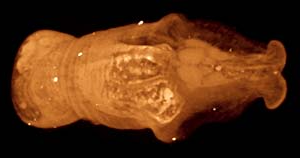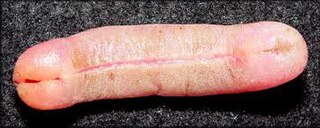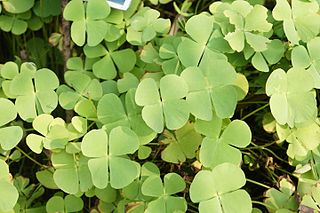
The little stint, is a very small wader. It breeds in arctic Europe and Asia, and is a long-distance migrant, wintering south to Africa and south Asia. It occasionally is a vagrant to North America and to Australia. The genus name is from Ancient Greek kalidris or skalidris, a term used by Aristotle for some grey-coloured waterside birds. The specific minuta is Latin for "small.

Tagetes is a genus of annual or perennial, mostly herbaceous plants in the sunflower family Asteraceae. They are among several groups of plants known in English as marigolds. The genus Tagetes was described by Carl Linnaeus in 1753.

Aplacophora is a monophyletic group of small, deep-water, exclusively benthic, marine molluscs found in all oceans of the world. All known modern forms are shell-less: only some extinct primitive forms possessed valves. The group comprises the two clades Solenogastres (Neomeniomorpha) and Caudofoveata (Chaetodermomorpha), which between them contain 28 families and about 320 species. The aplacophorans are traditionally considered ancestral to the other mollusc classes. However, the relationship between the two aplacophoran groups and to the other molluscan classes and to each other is as yet unclear.

Asterophora is a genus of fungi that grow as parasites on mushrooms. The genus contains four species, which have a widespread distribution, especially in temperate areas. The most recently described species, A. salvaterrensis, was found in Pinus pinaster forests in Galicia. Asterophora species are characterized by the massive production of chlamydospores in their fruit bodies and by the production of carminophilous lysosomes in their basidia. A frequently used but synonymous genus name is Nyctalis. The chlamydospores have been classified in the genus Ugola, which is an anamorphic name.

The Solenogastres, common name the solenogasters, are one subclass of small, worm-like, shell-less molluscs (Aplacophora), the other subclass being the Caudofoveata (Chaetodermomorpha).

Marchena is a genus of jumping spiders only found in the United States. Its only described species, M. minuta, dwells on the barks of conifers along the west coast, especially California, Washington and Nevada.

The marsh tchagra or blackcap bush-shrike is a species of passerine bird placed in the monotypic genus Bocagia in the family Malaconotidae. It is native to marshes in the tropics and subtropics of Africa. It is sometimes placed in the genus Tchagra.
Micropilina is a genus of monoplacophoran mollusks. They are very small, mostly deepwater animals which have a superficially limpet-like shell.

Tagetes minuta is a tall upright marigold plant from the genus Tagetes, with small flowers, native to the southern half of South America. Since Spanish colonization, it has been introduced around the world, and has become naturalized in Europe, Asia, Australasia, North America, and Africa. Tagetes minuta has numerous local names that vary by region. In the Andes it is known as Huacatay or Wacatay, and in other regions it is common as chinchilla, chiquilla, chilca, zuico, suico, or anisillo. Other names include muster John Henry, southern marigold, khakibos, stinking roger, wild marigold, and black mint.

Periballia is a genus of Mediterranean plants in the grass family.

Tryblidiida is a taxon of monoplacophoran molluscans containing the only extant representatives: 37 species are still alive today, inhabiting the ocean at depths of between 175 and 6,400 metres.

Aphia minuta, the transparent goby, is a species of the goby native to the northeastern Atlantic Ocean where it can be found from Trondheim, Norway to Morocco. It is also found in the Mediterranean, Black Sea and the Sea of Azov. It is a pelagic species, inhabiting inshore waters and estuaries. It can be found at depths of from the surface to 97 metres (318 ft), though it is usually found at 5 to 80 metres, over sandy and muddy bottoms and also in eelgrass beds. This species can reach a length of 7.9 centimetres (3.1 in) TL. It is an important species to local commercial fisheries. It is currently the only known member of its genus.
Notomenia is a genus of cavibelonian solenogasters, shell-less, worm-like, marinemollusks. In this genus the animal bears non-mineralized sclerites. This genus is the sole representative of the family Notomeniidae, and has secondarily reduced its radula, which is vestigial.
Sandalomenia is a genus of solenogaster, and the only genus in its family.
Heteroherpia is a genus of solenogaster, and the only genus in the Heteroherpiidae family.

Neomenia is a genus of solenogaster, and the only genus in its family.
Cyclomenia is a genus of cavibelonian solenogaster, a kind of shell-less, worm-like mollusk.

Epimenia is a genus of cavibelonian solenogasters, a kind of shell-less, worm-like mollusks. During the development of species in this genus, the sclerites start out as solid tips, then a hollow stalk develops that is subsequently infilled.
Pruvotinidae is a diverse taxonomic family of cavibelonian solenogasters, shell-less, worm-like marine mollusks.

Marsilea minuta, or dwarf waterclover is a species of aquatic fern in the family Marsileaceae. It is not to be confused with Marsilea minutaE.Fourn. 1880, which is a synonym for Marsilea vestita. Other common names include gelid waterklawer, small water clover, airy pepperwort, and pepperwort, though the lattermost also applies to plants in the genus Lepidium. In French it is called marsilea à quatre feuilles and petite marsilée, the latter appearing to be a calque with the Latin botanical name. In Chinese it is 南国田字草, literally "southern field word grass," referencing the similarity of the leaflet shape to the Chinese character for "field." The Koch Rajbongshi people and Garo people call it shusni shak. It is called 'শুশনি শাক' in Bengali. In parts of India it can be called sunisanakka In Indonesian it is semanggi, but this name also applies to Marsilea crenata. In Japanese it is nangokudenjiso and in Thai it is phakwaen. In Malaysian it is tapak itek. In the Philippines it is kaya-kayapuan.











